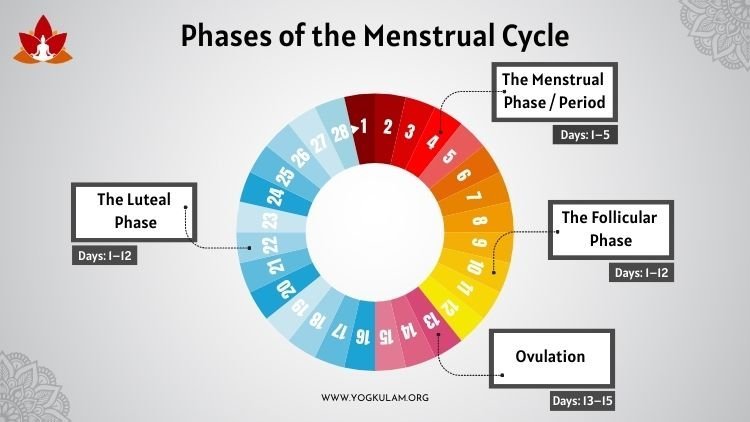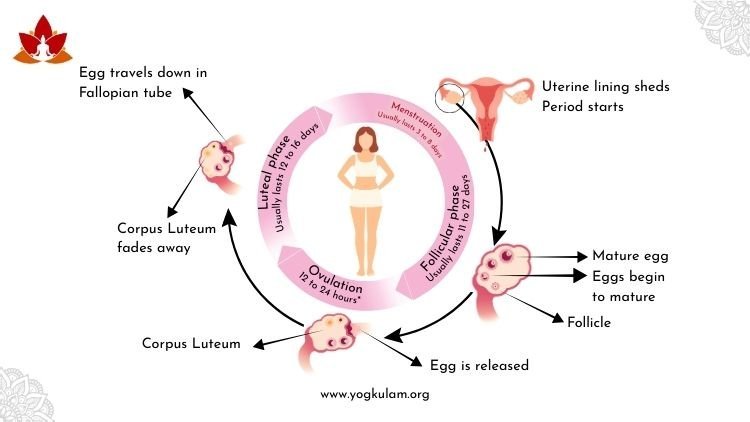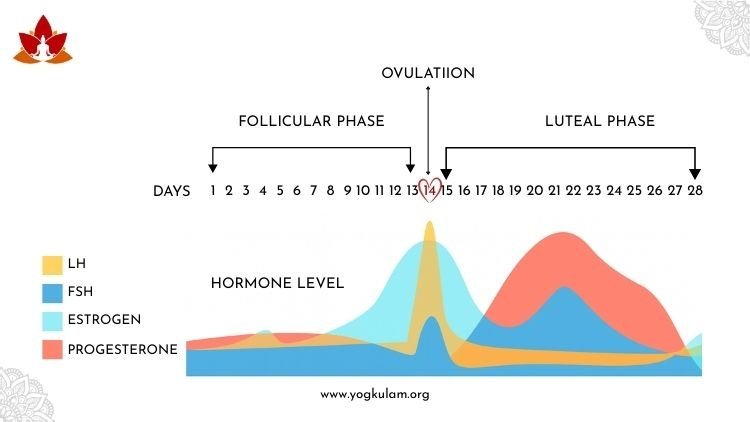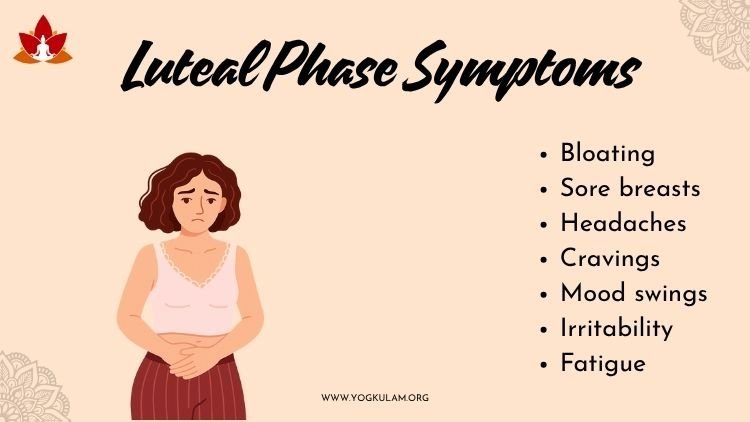What is the Luteal Phase & How to Manage It

PMS might get all the attention, but it’s only a small part of what happens during the luteal phase—a crucial stage of the menstrual cycle. So, what exactly is it?
The luteal phase occurs in the second half of your cycle, typically from day 15 to day 28 in a standard 28-day cycle. It begins after ovulation and ends when menstruation starts. During this time, your body works hard to prepare for a potential pregnancy by thickening the uterine lining to support implantation.
It’s also during this phase that many people experience symptoms like bloating, mood swings, fatigue, and food cravings. While these sensations can be overwhelming, they don’t have to take over your life.
-
Understanding your body’s rhythm
-
Adopting nourishing lifestyle practices
-
Supporting hormone balance naturally
can help you navigate this phase with more ease and grace.
Importantly, issues in the luteal phase—such as short luteal length or hormonal imbalances—can affect fertility, making it harder to conceive or sustain a pregnancy.
Stay tuned as we dive deeper into luteal phase symptoms, natural coping strategies, and how yoga and lifestyle changes can support this powerful phase of your cycle.
What is the Luteal Phase of the Menstrual Cycle?
The luteal phase is the second half of your menstrual cycle, beginning right after ovulation—when your ovary releases an egg—and lasting for about 14 days, until your next period begins.
During this time, your body shifts into preparation mode for a potential pregnancy. Here's what happens:
-
The egg travels from your ovary, through the fallopian tube, and into your uterus.
-
If fertilization occurs (the egg meets sperm), the fertilized egg may implant into the uterine lining, resulting in pregnancy.
-
If no fertilization or implantation happens, hormone levels drop, the thickened uterine lining sheds, and your period begins, marking the end of the luteal phase.
The luteal phase plays a vital role in reproductive health, and imbalances here can impact both menstrual regularity and fertility.
Phases of the Menstrual Cycle


Your menstrual cycle is divided into four distinct phases, each playing a vital role in reproduction and overall hormonal balance:
-
Menstruation (Period)
This phase marks Day 1 of your cycle. The uterine lining (endometrium), which built up in preparation for a pregnancy, sheds through the vagina if fertilization hasn't occurred. This shedding is what we call your period. -
Follicular Phase
Begins at the same time as menstruation and overlaps with it. During this phase, your ovaries begin to mature several eggs within fluid-filled sacs called follicles. One of these becomes the dominant follicle, preparing to release an egg. -
Ovulation
Around the middle of your cycle, the mature egg is released from your ovary and begins its journey down the fallopian tube. This is the most fertile window of the cycle. -
Luteal Phase
After ovulation, the egg travels toward the uterus. The uterine lining thickens in preparation for a possible pregnancy. If fertilization doesn't happen, hormone levels drop, the lining breaks down, and your next period begins.
What Occurs in the Luteal Phase?

The luteal phase begins right after ovulation, when the dominant follicle (which released the egg) transforms into a temporary hormone-producing gland called the corpus luteum.
This structure produces progesterone, along with a smaller amount of estrogen, which play key roles in preparing your body for a potential pregnancy.
Here’s what the rising hormone levels do:
-
Thicken the uterine lining (endometrium): Progesterone helps build a soft, nutrient-rich lining where a fertilized egg could implant and grow.
-
Protect the uterus: Your cervical mucus becomes thicker and stickier, acting as a barrier to block bacteria from entering the uterus.
If fertilization doesn’t occur, the corpus luteum breaks down, hormone levels drop, and the uterine lining sheds—marking the start of your next menstrual period.
Is the Luteal Phase Always 14 Days?
While the average menstrual cycle is about 28 days, the luteal phase—the second half of your cycle—typically lasts 12 to 14 days. However, just like cycles themselves, luteal phases can vary.
What’s Normal?
A healthy luteal phase can range from 10 to 17 days in length.
Short Luteal Phase

A luteal phase shorter than 10 days may be considered too short. This can be a concern because:
-
The uterine lining may not have enough time to grow thick enough to support an embryo.
-
This can lead to difficulties conceiving or early miscarriage.
A short luteal phase might indicate a condition known as Luteal Phase Defect (LPD), where the body doesn’t produce enough progesterone to maintain a pregnancy.
Long Luteal Phase
A luteal phase longer than 17 days is less common and may be caused by:
-
Hormonal imbalances, such as those seen in PCOS (Polycystic Ovary Syndrome).
-
In some cases, a delayed period may be an early sign of pregnancy.
If your period hasn’t arrived 18 days after ovulation, it might be time to take a pregnancy test.
How Can I Tell If I’m in the Luteal Phase?
Identifying whether you’re in the luteal phase of your menstrual cycle can offer insights into your hormonal balance, fertility window, and emotional well-being. While not everyone experiences noticeable changes, here are two key signs to look for:
1. Basal Body Temperature (BBT) Shift
One of the most reliable indicators is tracking your basal body temperature, which is your body’s temperature at complete rest (typically measured first thing in the morning).
-
After ovulation, BBT rises slightly—about 0.4°F (0.22°C) or more.
-
This rise is caused by increased progesterone, which is released during the luteal phase.
-
If your BBT stays elevated for over 10–14 days, it suggests you’re in (or nearing the end of) the luteal phase.
Tip: Use a BBT thermometer and track your temperature daily for at least one full cycle for accurate insight.
2. Vaginal Discharge Changes
Your cervical mucus consistency also changes with each phase of your cycle.
-
During ovulation, it's clear, stretchy, and slippery—often compared to raw egg whites (fertile mucus).
-
In the luteal phase, discharge becomes thicker, tackier, and drier, reflecting rising progesterone levels and the body's shift away from peak fertility.
What Are the Physical Symptoms of the Luteal Phase?

Before diving into how to support yourself during the luteal phase, let’s first explore the physical changes your body may experience. These symptoms are linked to natural hormonal shifts—primarily progesterone and estrogen—and can vary widely from person to person. Some may breeze through this phase, while others feel its full intensity.
Here are the most common physical symptoms of the luteal phase:
1. Breast Tenderness or Swelling
Rising progesterone levels can make breasts feel sore, heavy, or swollen—similar to what’s felt early in pregnancy.
2. Bloating
Water retention is common due to hormonal fluctuations, leaving you feeling puffy, especially in the abdomen.
3. Fatigue
You might feel more sluggish or tired than usual. Your energy naturally dips as the body prepares for a possible pregnancy—or menstruation.
4. Food Cravings
Hormonal imbalances can trigger cravings for carbs, sweets, or salty snacks. This is your body seeking serotonin and quick energy sources.
5. Acne or Oily Skin
Increased oil production and inflammation from hormonal changes can lead to breakouts, especially around the chin and jawline.
Five Consequences of the Luteal Phase on the Mind and Emotions
The luteal phase affects not just your physical health but also your mental and emotional well-being. You're not dreaming if you've ever had strange feelings of sensitivity, overwhelm, or just not feeling like yourself in the days before your period!
Hormonal shifts, particularly the increase and decline of estrogen and progesterone, can play a huge role in how you think, feel, and behave around the people around you.
Progesterone calms the brain at its peak, but as it begins to drop nearer your period, you can become more sensitive to emotional highs and lows. No, you're not going crazy at this time. You're simply at the mercy of this drop in progesterone.
Some (possibly irritating) emotional symptoms you may experience are listed below:
1. Mood swings: One moment you're crying at a commercial, and the next you're smiling at a humorous video. Hormone fluctuations are the cause of these, especially as progesterone levels begin to fall closer to your period.
2. Greater sensitivity to stress: No matter if it's a stressful workday or even a petty fight, you may find that your capacity for coping with pressure is slightly lessened at this stage.
3. Anxiety or sadness: Even if there is nothing particular happening in your life to explain it, it's normal to feel more depressed or nervous during the luteal phase. It can be difficult to get rid of the restlessness or impatience that these emotions frequently accompany.
4. Difficulty sleeping: As progesterone levels decrease later in the luteal phase, you may find it more difficult to sleep or maintain sleep. Poor sleep can then make you even more emotional or exhausted the following day.
5. Brain fog or difficulty concentrating: Do you have trouble focusing on work, school, or even casual conversations? Many people say that during the luteal phase, they feel mentally hazy.
How to Relieve Luteal Phase Symptoms: 8 Gentle, Effective Tips

Let’s face it — the luteal phase isn’t exactly a walk in the park. Hormones are shifting, your body is working overtime, and your mood might feel like it’s on a rollercoaster. But with a little self-compassion and smart care, you can feel more balanced and supported through it all.
Here are 8 soothing, practical ways to ease common luteal phase symptoms:
1. Nourish Yourself Wisely
What you eat has a powerful effect on how you feel. Try adding magnesium-rich foods like spinach, almonds, and bananas to help ease cramps and irritability. Omega-3s (found in walnuts and salmon) are great for lifting mood and fighting inflammation.
Craving chocolate? Go for dark chocolate — it satisfies your sweet tooth and supports your body too!
2. Hydrate Like It’s Your Superpower
Water helps with bloating, fatigue, and mood. Sip throughout the day, or make it more fun with herbal teas, lemon-cucumber water, or sparkling water with mint.
3. Prioritize Deep, Restful Sleep
The luteal phase can drain your energy. Aim for 7–9 hours of sleep and create a calming nighttime ritual: dim the lights, unplug from screens, and listen to something soft like music or a meditation.
Even if sleep doesn’t come easily, just resting your body and mind counts.
4. Move to Feel Better, Not Just to Burn Calories
Gentle movement like yoga, stretching, or a light walk can help with cramps, bloating, and low mood. If you're up for more, a light dance session or casual bike ride might boost your energy and spirits.
5. Manage Stress with Soothing Rituals
This phase can bring headaches, anxiety, and low mood. Create space for calm:
-
Practice mindfulness
-
Do deep breathing exercises
-
Try journaling to process thoughts and emotions
The more tools in your stress-relief toolkit, the better.
6. Track Your Cycle & Emotions
Using a period tracking app or a simple journal helps you notice patterns — when you feel good, when you don’t, and how to plan for both. It’s empowering to know what’s coming.
7. Ask About Supplements
Some supplements may help ease PMS and luteal symptoms — like vitamin B6, magnesium, or chasteberry. But don’t DIY this; check in with a healthcare provider before trying anything new.
8. Listen to Your Body
This is your time to slow down and tune in. Feel tired? Rest. Feeling disconnected? Call a friend. Craving something sweet? It’s okay. Be gentle with yourself.
If your symptoms are intense or interfering with your life, seek support from a professional — you don’t have to power through alone.
Final Thoughts: Why Knowing Your Cycle Matters
Understanding the phases of your menstrual cycle — especially the luteal phase — empowers you to better care for your body and your overall well-being. Whether you're trying to conceive or simply want to feel more in sync with your natural rhythms, being aware of these changes can make a big difference.
If you’re concerned about irregular cycles, lack of ovulation, or a short luteal phase, don’t hesitate to reach out to a fertility specialist or healthcare provider. Even if pregnancy isn’t your goal, learning how your cycle affects your hormones, energy, and mood is key to supporting your health.
Knowledge is power — and in this case, it’s also self-care.
Frequently Asked Questions (FAQs) About the Luteal Phase
1. How long should a luteal phase be in order to conceive?
A healthy luteal phase typically lasts 10 to 16 days, with 14 days being most common. If it’s shorter than 10 days, your uterine lining might not have enough time to properly thicken, making it harder for a fertilized egg to implant. That said, everyone is different — and a short luteal phase doesn’t automatically mean you can’t conceive. It’s best to consult a healthcare professional if you’re trying to get pregnant.
2. What should I know about the luteal phase if I'm trying to get pregnant?
The luteal phase is the waiting window between ovulation and your period. If you're trying to conceive, this phase can feel like a suspenseful countdown. A luteal phase shorter than 10 days might point to a luteal phase defect, which can make it harder to sustain a pregnancy.
If you're tracking your cycle for fertility, this is the time to:
-
Monitor for symptoms (like fatigue or breast tenderness).
-
Track your basal body temperature or use ovulation kits.
-
Watch for early pregnancy signs before taking a test.
Even if you’re not trying to conceive, tracking your luteal phase helps identify hormonal imbalances or irregularities.
3. How do I monitor my luteal phase?
To track your luteal phase:
-
Start tracking after ovulation, which you can identify by:
-
A rise in basal body temperature.
-
Changes in cervical mucus (it becomes thick and dry).
-
Using an ovulation predictor kit.
-
Count the days from the day after ovulation until your next period — that’s your luteal phase.
Apps, fertility trackers, or even a basic calendar can help you track patterns over time.
4. What should I avoid during the luteal phase?
Certain lifestyle choices can make luteal phase symptoms worse. Here’s what to avoid:
-
Excess sugar and processed foods: Can spike your blood sugar, worsen bloating, and increase irritability.
-
Caffeine and alcohol: May heighten anxiety, disrupt sleep, and contribute to mood swings or fatigue.
Instead, go for balanced meals, herbal teas, and plenty of hydration.
5. Are severe emotional symptoms during the luteal phase treatable?
Yes, they are! If you experience severe mood swings, anxiety, or depression that interfere with daily life, you may have PMDD (Premenstrual Dysphoric Disorder) — a more intense form of PMS.
Treatment options include:
-
Therapy and lifestyle changes (like yoga or journaling).
-
Medication such as antidepressants or hormonal birth control.
-
Supplements like magnesium, calcium, or vitamin B6 (with professional guidance).
What's Your Reaction?


























